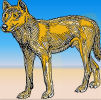Claims that DNA from a 350-year-old dingo tooth could save the species in Australia are rubbish, dingo conservationists say
 In response to claims that DNA from a 350-year-old dingo tooth could save the species in Australia, National Dingo Preservation and Recovery Program spokesperson Dr Ian Gunn said the reverse was the case. “On past experience, the evidence will be used to justify a continued sheep industry campaign to exterminate the species across Australia. Just because of the introgression of domestic dog genetics in some individuals, or because they are not the dingo variety identified by the genes in this ‘one-tooth’, they then falsely claim the animals they are killing are not real dingoes."
In response to claims that DNA from a 350-year-old dingo tooth could save the species in Australia, National Dingo Preservation and Recovery Program spokesperson Dr Ian Gunn said the reverse was the case. “On past experience, the evidence will be used to justify a continued sheep industry campaign to exterminate the species across Australia. Just because of the introgression of domestic dog genetics in some individuals, or because they are not the dingo variety identified by the genes in this ‘one-tooth’, they then falsely claim the animals they are killing are not real dingoes."
The Dingo Genome
The dingo genome was identified first by the late Dr Allan Wilton. His research partner, Dr Kylie Cairns has recently discovered that there was more than one dingo introduction, at least two, probably with varying genetics.
Dr Gunn said,
“Given the long pre-history of trade between northern Australian Aborigines and the seafarers thought to have brought the dingo to Australia - from the Middle East, India and South East Asia over thousands of years - there is little doubt there were many introductions. In this context it is amazing to find a University of the Sunshine Coast researcher now seeming to claim the tooth of one will reveal ‘the full genomic breakdown of the pure dingo’. It will really only reveal the genome of one race of dingo, descended from one of an unknown number of introductions."
He added that the trouble with DNA science on this subject is its misuse by proponents of broad-hectare baiting, on the grounds that a small proportion of domestic dog genes means the animal is not a real dingo. He called a preoccupation with genetic purity a "distraction from the real issue, which is apex predator ecological function, which most hybrids are performing."
“In any case, the construction of a pre colonisation genetic benchmark would need to be representative and the collection of enough pre-settlement samples to achieve this, especially given evidence of different lineages, would be virtually impossible," he argued.
Current 'solutions' make the problem worse
On the issue of baiting, he stated:
“Baiting is a cruel and massively taxpayer funded industry with its own profit making agenda. It is already destroying ecological balances, endangering wildlife and, for farmers, worsening all the problems it claims to be solving. Broad-hectare baiting has already caused immense problems for farmers by driving dingoes from public lands, where they should be left alone, onto people’s farms."
“Proponents say it disrupts dingo pack structure and forces the dingoes to move on, as though these are good things. Farmers with properties adjoining public land might ask the authorities where the dingoes move on to, because the answer is their place."
“The breakdown of pack structure caused by baiting is the prime cause of the hybridization these people also claim to be concerned about. Without pack disruption, stable dingo packs will kill rather than breed with wild or stray dogs."
He observed that some cattle graziers say they are better off with dingoes controlling herbivore numbers and vegetable and grain growers have fewer problems with rabbits and rats. Even sheep farmers have far worse problems than dingoes – heat, cold, drought, flood and the real feral predators of the piece, the banks.
Millions of dollars wasted on baiting
“Dingoes are such an insignificant, though exaggerated problem, that official statistics in Victoria show it would be dramatically cheaper to pay farmers a better than market price for lost sheep than to spend the millions of dollars now being used to subsidise baiting."
Despite this reality, he said that the new research into the genes from one tooth will be used to manufacture public consent for more baiting, more poison and more extermination.
“Farmers will be worse off and so will we all,” he concluded.

Recent comments